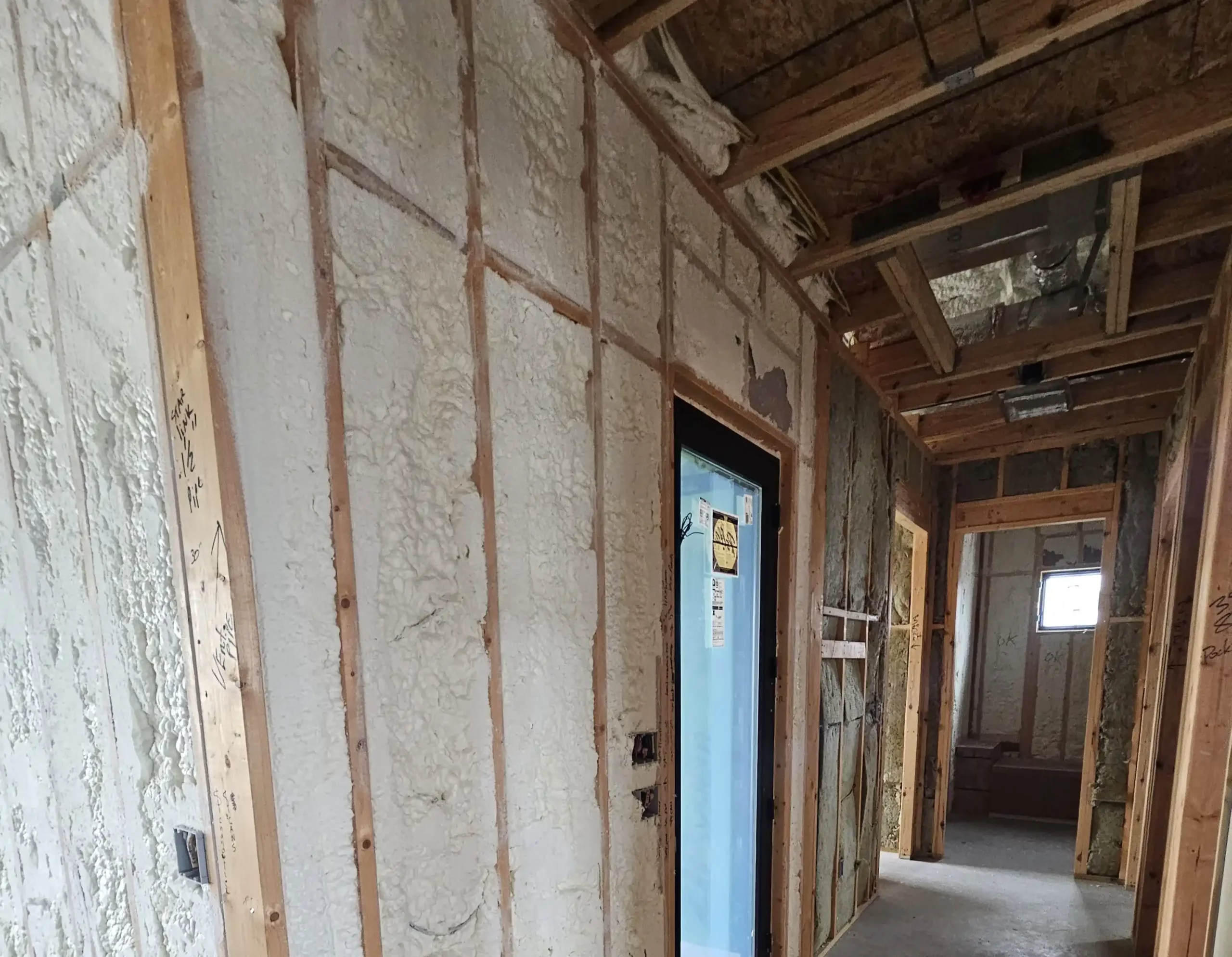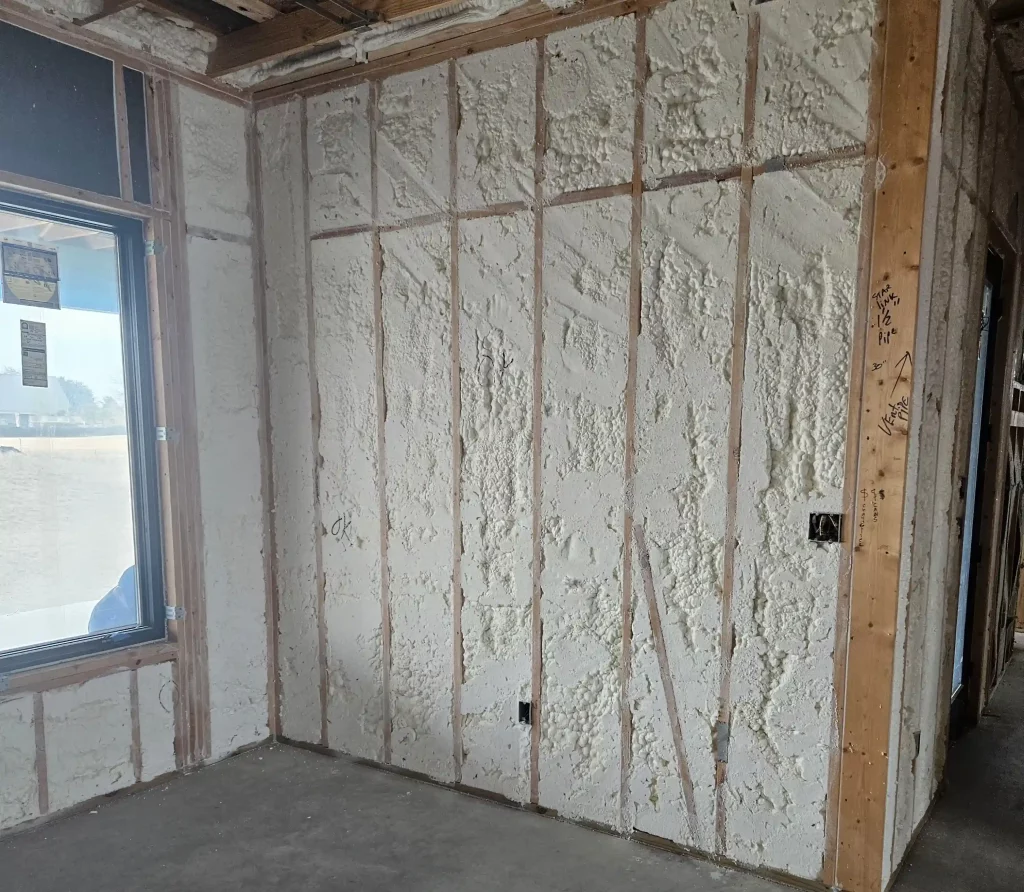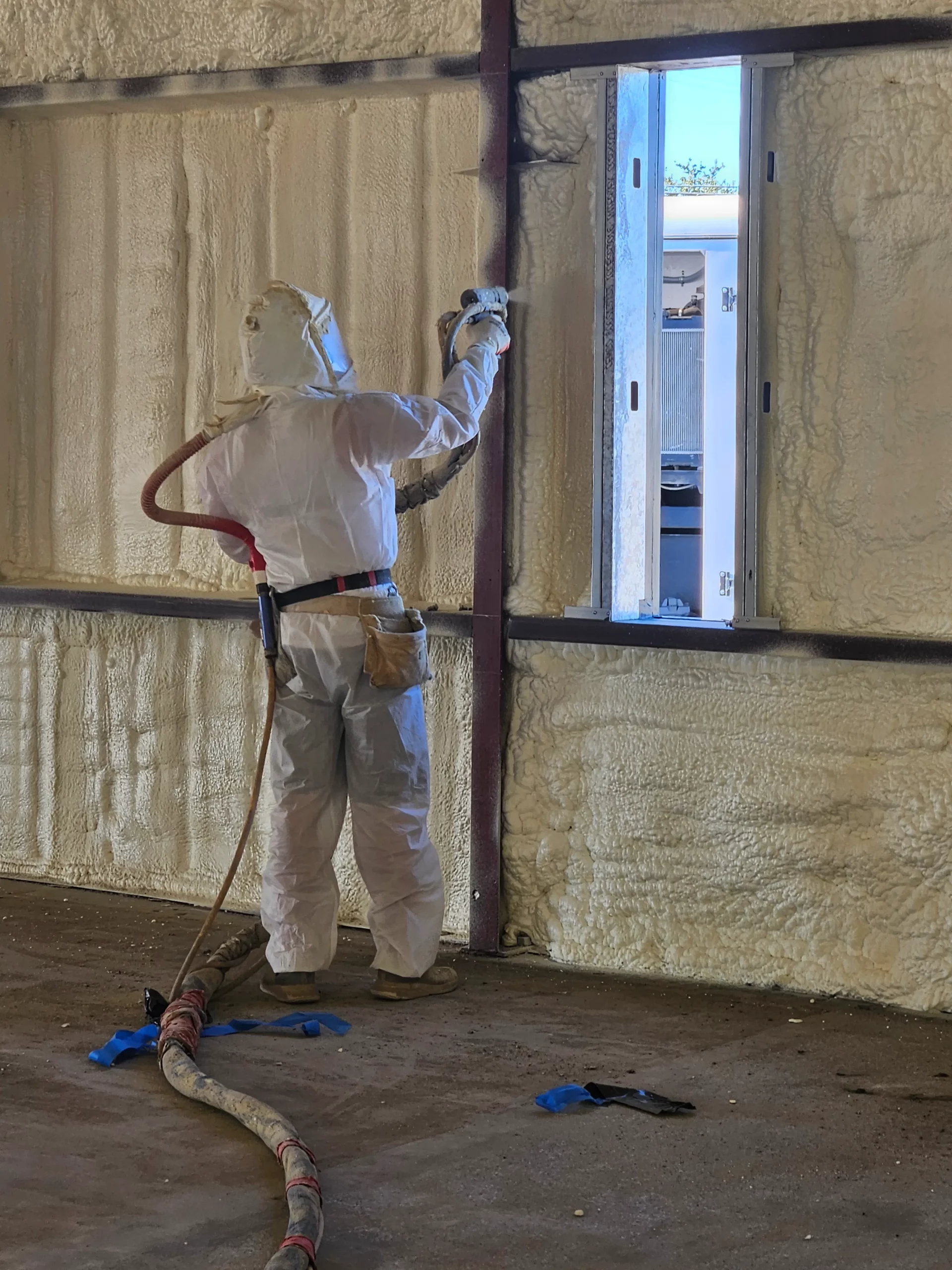

Spray foam insulation reduces energy bills by creating an airtight thermal barrier that stops heated and cooled air from escaping through gaps, cracks, and poorly sealed areas in homes. In Killeen’s hot summers and variable winters, this translates to 20-50% reductions in monthly energy costs, with most homeowners seeing payback within 2-5 years through lower utility bills.
The key lies in spray foam’s ability to seal air leaks while providing superior R-value compared to traditional insulation materials. Unlike fiberglass batts that leave gaps around electrical outlets, pipes, and irregular spaces, spray foam expands to fill every crevice, creating a continuous insulation envelope. This comprehensive approach addresses the primary cause of energy waste in Texas homes – uncontrolled air infiltration.
Two main types of spray foam insulation offer different benefits for bill reduction. Open-cell spray foam provides excellent air sealing with moderate insulation value, while closed-cell foam delivers maximum thermal resistance and moisture protection.
| Foam Type | R-Value per Inch | Air Sealing Capability | Moisture Resistance | Best Applications |
|---|---|---|---|---|
| Open-Cell | 3.5-3.8 | Excellent | Moderate | Attics, interior walls, sound control |
| Closed-Cell | 6.0-7.0 | Superior | Excellent | Exterior walls, basements, and roofing |
| Fiberglass (comparison) | 2.2-2.7 | Poor | Poor | Traditional applications |
Open-cell foam costs less initially but requires thicker applications to achieve desired R-values. Closed-cell foam provides twice the insulation value per inch, making it ideal for areas with space constraints like exterior walls in older Killeen homes.
Bonus Tip: Focus spray foam application on the top plates of walls in attic spaces – these areas typically have the largest air leaks and provide the highest return on investment for energy savings.
Killeen’s climate zone 3A presents unique challenges with hot, humid summers reaching 100°F and occasional winter temperatures below freezing. Spray foam addresses these conditions better than traditional insulation materials.
During summer months, spray foam prevents hot outdoor air from infiltrating conditioned spaces while keeping cool air inside. The moisture resistance of closed-cell foam prevents condensation issues that plague fiberglass insulation in humid conditions, maintaining consistent thermal performance year-round.
| Climate Challenge | Traditional Insulation Impact | Spray Foam Solution | Energy Bill Effect |
|---|---|---|---|
| Summer Heat (95-105°F) | Air gaps allow heat infiltration | Complete air sealing | 25-40% cooling cost reduction |
| High Humidity (60-80%) | Moisture reduces effectiveness | Moisture barrier protection | Consistent performance |
| Temperature Swings | Thermal bridging increases loads | Eliminates thermal bridges | 15-25% additional savings |
Winter heating benefits prove equally significant. Spray foam prevents warm air from escaping through stack effect – the natural upward movement of heated air that drives energy loss in homes. This complete envelope sealing maintains comfortable temperatures with less furnace runtime.
Bonus Tip: Schedule spray foam installation during moderate weather periods (spring or fall) when HVAC systems aren’t working hardest – this allows immediate energy savings measurement.
Targeting the right areas for spray foam application maximizes energy savings per dollar invested. Attic spaces typically offer the highest return, followed by exterior walls and basement or crawl space applications.
Attic spray foam application to the underside of roof decking creates conditioned attic space, protecting HVAC equipment and ductwork from temperature extremes. This approach often doubles the efficiency of existing HVAC systems by eliminating duct losses.
Exterior wall applications prove most beneficial in older Killeen homes where original insulation has settled or degraded. Spray foam injection through small holes provides comprehensive coverage without major renovation disruption.
Basement and crawl space applications address ground moisture and temperature differentials that force HVAC systems to work harder. Closed-cell foam on foundation walls creates a thermal break that reduces both heating and cooling loads.
Bonus Tip: Combine spray foam with programmable thermostats and HVAC maintenance for compound savings – proper insulation allows more efficient temperature control strategies.

Spray Foam Tech provides comprehensive insulation solutions designed to maximize energy bill reductions for Killeen homeowners. Each installation focuses on identifying and sealing the specific air leakage points that drive high energy costs.
Residential Spray Foam: Complete home envelope sealing using both open-cell and closed-cell applications tailored to specific areas and energy saving goals.
Commercial Spray Foam: Large-scale applications for businesses seeking substantial utility bill reductions through professional-grade insulation systems.
Spray Foam Roofing: Continuous roofing insulation that eliminates thermal bridging while providing weatherproof protection and energy savings.
Insulation Removal: Safe removal of old, ineffective insulation materials before spray foam application to ensure optimal performance and maximum bill reduction.
Accurate measurement of spray foam’s impact on energy bills requires consistent monitoring and comparison methods. Utility bill analysis over 12-month periods provides the most reliable savings calculations.
Degree-day adjustments account for weather variations between measurement periods, ensuring accurate savings attribution to insulation improvements rather than climate differences. Most utility companies provide historical usage data for comparison purposes.
Smart thermostats and energy monitoring systems track real-time usage changes, helping homeowners understand how spray foam affects daily energy consumption patterns. These tools identify additional opportunities for optimization and savings enhancement.
Professional post-installation assessments verify performance through thermal imaging and blower door testing, confirming that expected bill reductions align with actual results.
To learn how Spray Foam Tech is growing to serve even more Texas homeowners with advanced insulation solutions, read more about our expanded insulation services.
Maximizing energy bill reductions through spray foam requires proper assessment, material selection, and professional installation techniques. Every home presents unique opportunities for savings based on construction details, existing insulation condition, and usage patterns.
Spray Foam Tech evaluates each property’s specific energy loss factors and recommends targeted solutions that deliver measurable bill reductions. Professional installation ensures proper coverage, curing, and performance that translates into immediate energy savings. Contact Spray Foam Tech at (737) 777-9590 or oldworldtx@hotmail.com to schedule a comprehensive assessment of your home’s energy saving potential through spray foam insulation.
Most homeowners notice reduced energy usage within the first billing cycle after installation. Maximum savings typically appear within 2-3 months as HVAC systems adjust to improved envelope performance and seasonal temperature changes demonstrate full benefits.
Attic applications typically deliver the fastest payback, followed by exterior walls and basement areas. Professional energy audits identify the specific sequence that maximizes bill reduction per dollar invested based on your home’s unique characteristics.
Proper spray foam installation often allows existing HVAC systems to operate more efficiently, potentially delaying replacement needs. However, systems nearing end-of-life should still be evaluated for efficiency improvements that compound insulation benefits.
Compare 12 months of pre-installation bills with 12 months post-installation, adjusting for degree-day differences. Divide total installation cost by annual savings to determine payback period, typically ranging from 2-7 years for most applications.
Quality spray foam installations maintain consistent performance for 20-30 years or more. Unlike traditional insulation that settles and degrades, properly installed spray foam retains its air sealing and thermal properties throughout its lifespan, ensuring continued bill reductions.


